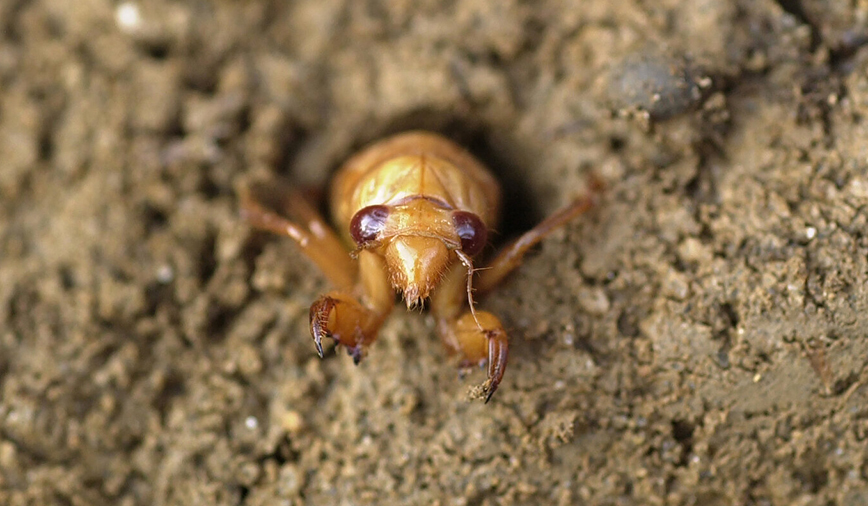Pam’s Perspective
From the…
Pam Otto is the Manager of Natural Programs and Interpretive Services for the St. Charles Park District
June 15, 2012
Remember the old PBS show, Sneak Previews? I used to love watching film critics Gene Siskel and Roger Ebert give their thoughts on new releases from their retro-theater set. I can still picture the opening sequence, with the popping corn and the malfunctioning pop machine. And thanks to the magic of YouTube, I now have the catchy opening tune playing over—and over—in my head.
Although that show is long gone, I was fortunate enough to take in not one but two Sneak Previews over the last couple of weeks. Even better, you can take advantage of these opportunities too.
All you have to do is poke around a little bit. In the dirt.
My first preview experience came about two weeks ago, as I was preparing a garden bed on the south side of my house. I’d gotten a later start than I’d hoped, and the waning sunlight made it a little tough to see what I was doing. But as the nearly full moon rose I found I could see well enough to get the job done.
About 20 minutes into the project, I noticed small spot on the ground that seemed to be glowing. I didn’t really think too much of it, figuring it was probably some bit of shiny debris reflecting the moon’s glow. So on I dug.
Then, maybe a half hour later, as I was nearing the edge of the garden, I saw another shiny bit. And another. And another.
Adobe Systems
Under normal circumstances, I would’ve stopped at the first hint of sparkle—after all, who can resist something shiny? I’d ignored that first one, given the late hour, but three more proved impossible to pass up.
Dropping to one knee, I probed the soil carefully. I had a hunch of what these shiny bits might be, but didn’t think I’d be lucky enough to find so many in one spot.
Sure enough, there they were—lightning bugs, emerging from their pupal cases.
As insects that undergo complete metamorphosis, lightning bugs—like butterflies, the most famous of the total transformers—start out as larvae that look nothing like their adult counterparts.
Juvenile lightning bugs, also known as glow worms, have always reminded me of roly-polies, or pill bugs, only with a much pointier snout and fewer legs—six, to be exact. Depending on species, the little guys can spend as long as two years in this stage, preying on worms, slugs and other soil-dwellers; they then form a mud case and metamorphose into the adult form we know so well.
And now, there they were, brand-new and right in front of me. Thoroughly distracted, I put any further garden prep on hold. For one thing, it was late and, two, I wasn’t going to be the one to disrupt the progress these amazing insects had taken so long to complete. Instead, I sat in the dirt and watched them crawl around; I picked one up and admired its soft newness. Then I got up, put the shovel away, and started counting the days until fully formed fireflies would fill the air. Sneak Preview No. 1: two thumbs up!
The next occasion took place about a week ago, during a Saturday morning Learn from the Experts program we hosted at Hickory Knolls. The topic was snakes, and 20-some participants turned out to clamber about the park’s hills, turning over logs and peering down holes in search of the day’s target species.
Snakes, as it turned out, were in short supply. But we did come upon several other notable creatures, including two toads, a paper wasp nest (ow) and…Sneak Preview No. 2.
We were near one of Hickory Knolls’ pothole wetlands, looking at this point for anything and everything of interest. Rolling over a log, hoping for a salamander, I instead saw the pale abdomen of what I at first thought was a stag beetle grub. But something didn’t look quite right.
That abdomen, which on a grub would be soft and white, was sclerotized and light yellow in color. Using my fingers, I gently dug the little critter out of its narrow burrow and found myself looking into the bulging eyes of an annual cicada nymph.
The male cicada’s droning song is one of the most recognizable sounds of summer. In fact, if you’re really good, you can even differentiate between species by listening to the pitch and duration, as well as noting the time that you hear the call.
But this little nymph, which had spent anywhere from two to five years buried in the soil, sucking on tree roots, still had some growing up to do. It needed at least a few more weeks before it could even consider singing. Or laying eggs, if it’s a female.
So as to not interrupt the process, I snapped a few quick pictures, then gently laid the little nymph back down in the soil. On contact, its brawny forelegs began digging and in a matter of a few seconds it was gone, back down into the safety of its burrow.
Although I’ve found cicada nymphs, still muddy, crawling across sidewalks on their way to a tree trunk to shed into adulthood, I’ve never witnessed one still in its burrow. What a lucky and, for naturalists, awe-inspiring find. Sneak Preview No. 2: Two more thumbs up!
I intend to spend a lot more time this summer in search of more such coming attractions. Nature’s show plays nonstop, so I feel confident of catching more previews as the season goes on. I’ll keep my eye out for re-releases, too.
And, come to think of it, a concession stand.
Pam Otto, who suddenly feels compelled to mention that prairie dropseed, Sporobolus heterolepsis, smells like buttered popcorn, is the manager of nature programs and interpretive services for the St. Charles Park District. She can be reached at 630-513-4346 or potto@stcparks.org.

